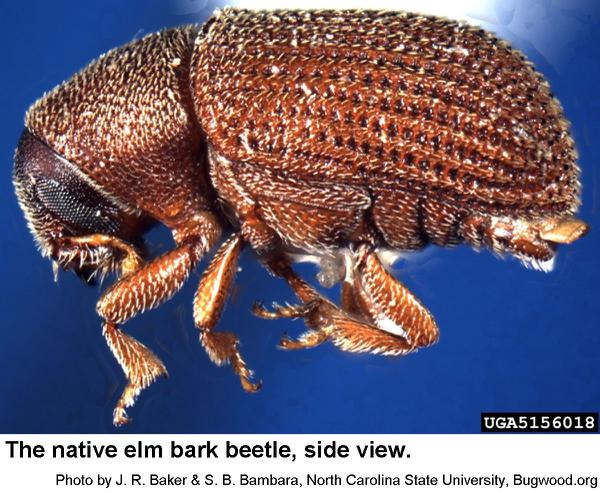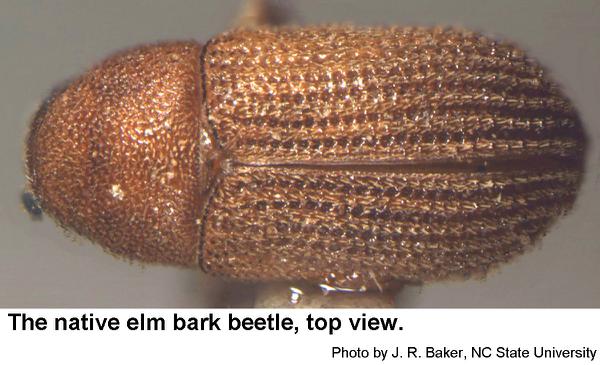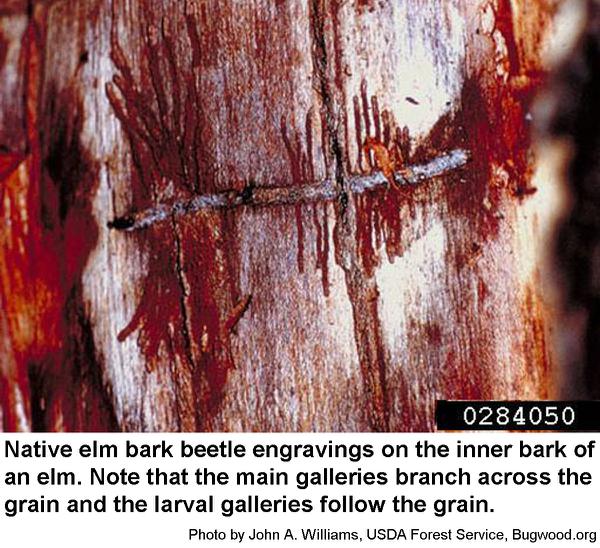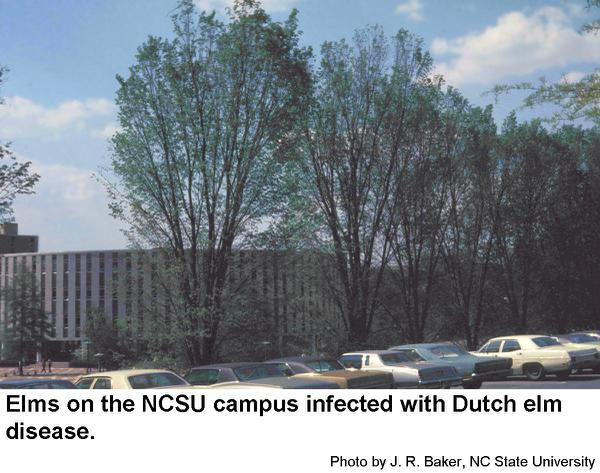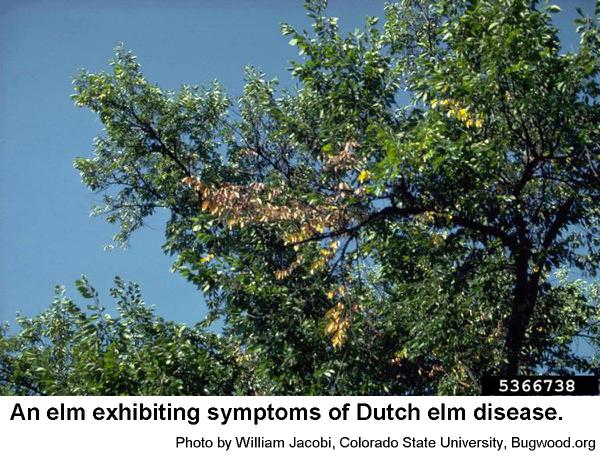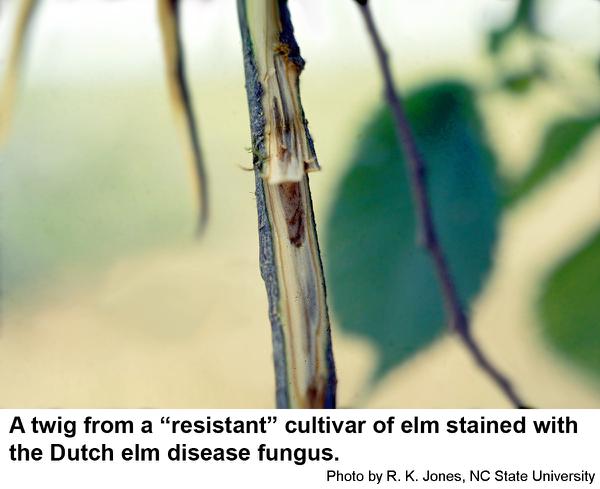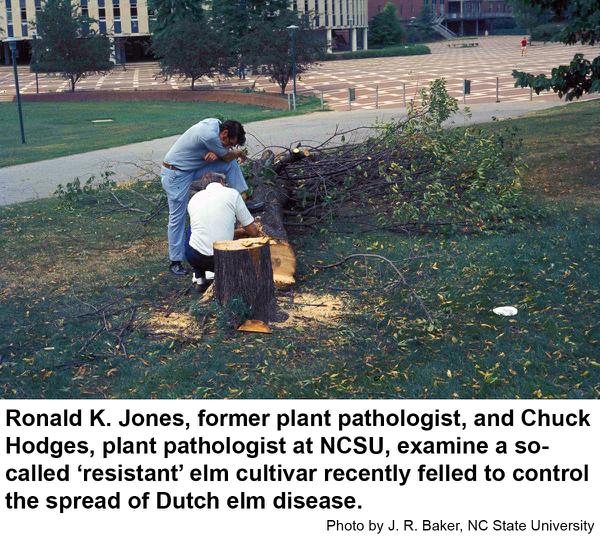Description and Biology
The native elm bark beetle, Hylurgopinus rufipes, is a small, brown to dark brown, insect almost 1/8 inch long. The wings and body are rough and have short, stiff, yellow hairs. They overwinter in the outer bark near the base of living elms, and as grubs in the inner bark of dead elms. They breed and construct egg galleries in dead and dying elm trees and even elm firewood. Males as well as females bore entrance tunnels through the bark. Most tunnels have a male near the entrance and a female constructing egg galleries to the left and right of the entrance tunnel between the inner bark and the wood. The egg galleries are formed across the grain of the wood. Minute, pearly white eggs are deposited close together along both sides of the galleries. Young grubs hatch from the eggs and tunnel at right angles to the egg galleries, usually following the wood grain. Once full grown, the white, legless grubs pupate and later emerge as adults. We probably have one generation per year in North Carolina.
Host Plants
Elms seem to be the only hosts for the native elm bark beetle, a vector of Dutch elm disease. American, red or slippery elm, rock elm and cedar elm are very susceptible to Dutch elm disease. Siberian elm is tolerant, but not resistant. These beetles carry the fungal spores of Dutch elm disease on their bodies. When the fungus is introduced into living elms, the water conducting vessels of the sapwood are blocked, killing the trees.
Residential Recommendations
Elms should be maintained by proper watering and fertilizing. Native elm bark beetle populations can be reduced by removing and destroying breeding sites such as dead and dying elms and elm firewood. Healthy elm trees should not be pruned between April 1 and August 31, as beetles are strongly attracted to open tree wounds. A pyrethroid insecticide applied to the lower 6 feet of the trunks of living elms during April and May should help protect elms from native elm bark beetles (but not smaller European elm bark beetles!). When used as directed, pyrethroids are very toxic to insects but are not particularly hazardous to humans and pets (other than fish-avoid using pyrethroids around pools, ponds, and streams). If elms are specified in a landscape plan, consider planting cultivars resistant to Dutch elm disease.
References
- An Identification Tool for Bark Beetles of the Southeastern United States. Baker, J. R. et al. 2010 (modified). Lucid Key. NC State University.
- Native elm bark beetle, Hyturgopinus (sic) rufipes. Anonymous. 2014 (last modified).Agriculture and Agri-Food Canada, Goverment of Canada.
- The Native Elm Bark Beetle, Hylurgopinus rufipes (Eichhoff). Kaston, B. J. 1939. Connecticut Agr. Exp. Station Bulletin 420. 39 pp.
- Elm bark beetle, native, Hylurgopinus rufipes, Order Coleoptera, Family Scolytida; bark or engraver beetles, Native pest. Krischik, V. and J. Davidson. 2013 (last modified). Pests of Trees and Shrubs. IPM of Midwest Landscapes.
- Extension Plant Pathology Publications and Factsheets
- Horticultural Science Publications
- North Carolina Agricultural Chemicals Manual
For assistance with a specific problem, contact your local Cooperative Extension Center.
This Factsheet has not been peer reviewed.
Publication date: Aug. 15, 2017
Reviewed/Revised: May 21, 2022
Recommendations for the use of agricultural chemicals are included in this publication as a convenience to the reader. The use of brand names and any mention or listing of commercial products or services in this publication does not imply endorsement by NC State University or N.C. A&T State University nor discrimination against similar products or services not mentioned. Individuals who use agricultural chemicals are responsible for ensuring that the intended use complies with current regulations and conforms to the product label. Be sure to obtain current information about usage regulations and examine a current product label before applying any chemical. For assistance, contact your local N.C. Cooperative Extension county center.
N.C. Cooperative Extension prohibits discrimination and harassment regardless of age, color, disability, family and marital status, gender identity, national origin, political beliefs, race, religion, sex (including pregnancy), sexual orientation and veteran status.

